
|
This page is about the many materials and methods I offer for making a
personalized book for the client who wants the most special and
ecclectic of personal items. This book is named for the client, who's
last name is Schiff. He wanted a book done in the style of
French/Flemish book arts of the end of the 15th century. The subject
matter is biblical, and you can see some of the major illuminations on
my Illuminated Manuscripts Art Page. The book is 5x7 inches,
Gothic bound in hardwood boards over dark blue goatskin. The pages are
all genuine goat parchment, written in medieval inks and illustrated
with genuine gold & silver leaf, and pigments made from plants,
animals, minerals and chemistry. The binding was hand sewn, carved and
tooled, and features hand-made metal bosses and clasp.
I am also currently writing a book on how to make a medieval book, entitled: Secrets Of Forgotten Masters: A 21st Century Artist's Exploration of how books were made in the Middle Ages. That book will be a comprehensive visual exploration of the materials and techniques used by medieval artists and craftsmen to produce entire books. It will feature sections on tool making, materials collection and manufacture, color making, and binding. Each section will be fully illustrated with photographs. The information will be documented from extant sources and treatises from the medieval period. |
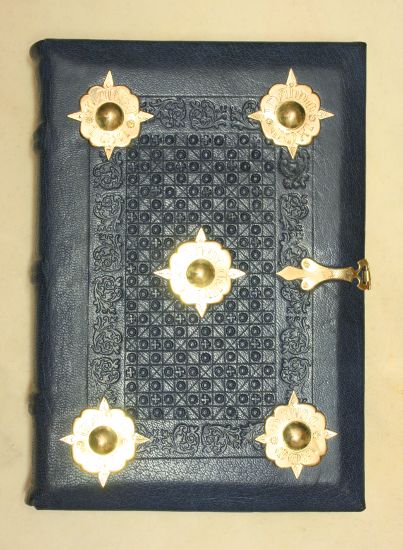 The Schiff Medieval Illuminated Manuscript Book Copyright 2011 Randy Asplund 5x7 inches. Medieval paints, gold and silver leaf, and oak gall ink on goatparchment. Brass hardware over dark blue tooled goat leather. Making Parchment 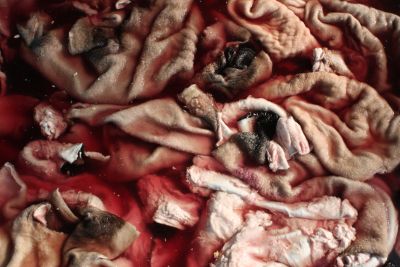 The
first step in making a medieval book is gathering the pages to write
upon. These were usually made from parchment, and later paper. The
parchment is made from the skins of goats, sheep, and calves. I use
both parchment that I have purchased and parchment that I have made.
Above is a pool of a dozen and a half goat and sheep skins soaking
after being flayed. I am removing the dirt, feces and blood from the
pelts before I process them.
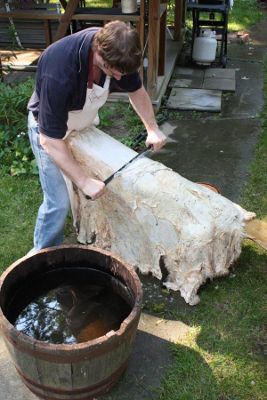 I made a
fleshing knife and this is me scraping the raw flesh from the inside of
a skin. The next stage will be to soak it in a lime water solution for
over a week, then scrape off the hair, and then soak it a second time
in lime water solution.
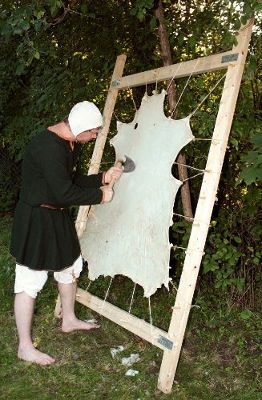 After
soaking, the skin is stretched on a frame and scraped very smooth with
a crescent shaped knife called a lunelarum. I am pictured here in 14th
c. costume using a reproduction lunelarum. The next step involves
drying, sanding with a block of pumice, and then smoothing the skin
until it is perfect. See the Ecclesiastes article for preparation of
the pages.
The Manuscript  I write
using a goose quill pen and I hold the parchment flat on my 15th c.
type writing slope with my 15th c. type of pen knife. I make these
tools to get a more authentic method in order that my work looks more
correct.
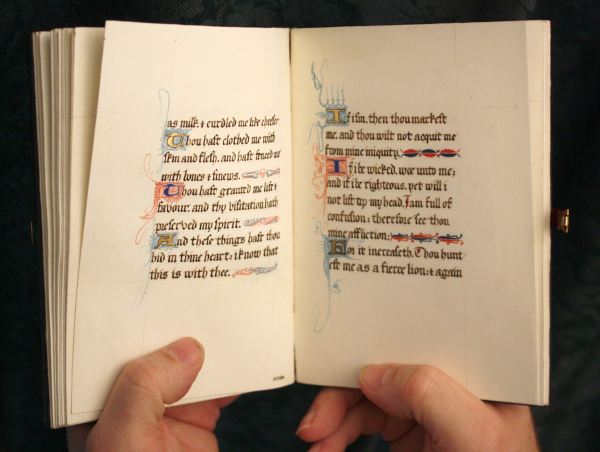 This is
what the finished calligraphy looks like in the Schiff book. There are
fine ink rulings using my home-made brazil wood ink, the dark blue is
coarse ground azurite and the pale blue is fine ground azurite pigment
that I made. The red is vermilion, and the dark brown/bladck ink is oak
gall ink that I made.
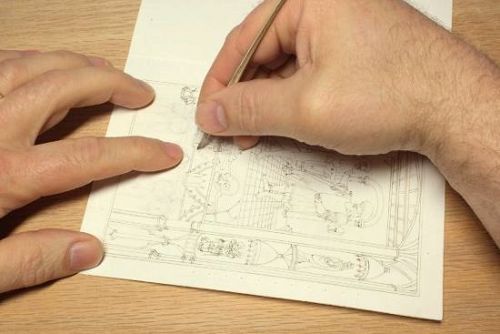 After
the calligraphy comes the illustrating Illustrations are called
Illuminations because the gold brightens the page with light, but it
generally refers to the painting. The design is drawn with
a lead/tin stylus known as a plumet that I made, and it is then inked
with dilute oak gall ink. Then I erase the plumet lines with a wad of
bread. This illustration is the Covenant Between Johnathan and David
full page miniature in the Schiff Book.
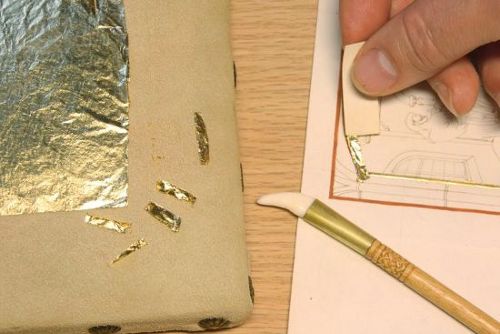 The
gilding follows the underdrawing after its contents have been inked. I
make a gesso ground from a red clay called bole, some chalk for a bulk
former, a few drops of honey, and some hide glue. I apply this wherever
the gold will be. After it dries I breathe on it to bring up a tack,
and then lay genuine gold leaf on it. When it is dry enough I burnish
with a burnisher that I made from the tooth of a dog or from another
agate burnisher that I made.
 Burnishing with an agate burnisher that I made Making Medieval Paints
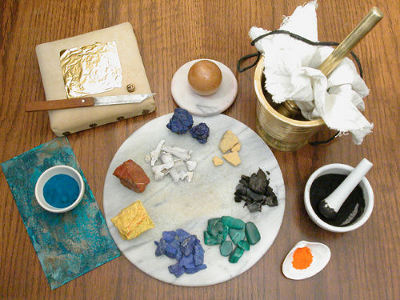 These
are justa few of the many colors that I make for my Medieval Manuscript
Illuminated Books. We have verdigris on a copper plate, and next to it
are yellow orpiment, iron oxide, calcined chicken bones, azurite,
yellow ochre, chared bone, vine and wood, red lead, malachite, and
lapis lazuli. I also make pigment from insects, other
minerals and chemicals, and a lot of different plants and even gall
bladders of fish and cows. The colors are made into paint with the
addition of sap from acacia, cherry or plum trees, and I also use the
fluid left after I beat egg whites. The later is called glair.
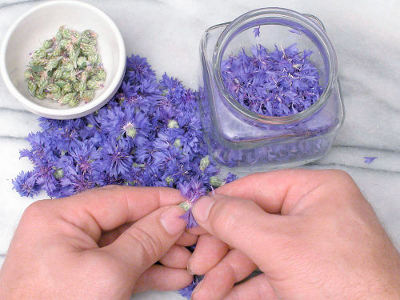 I
process the petals of cornflowers, irises, violets, poppies, the
berries of buckthorne, elder, and european bilberries and many more
plants to extract vibrant hues. While not lightfast for display in a
frame, they last centuries when used in a book.
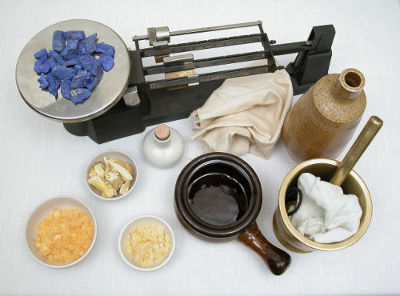
Ultramarine was collected only in Afghanistan during the middle ages.
It is mined today as it was back then, with pick axes by hand. From
there it travels by mule and camel, always in danger, and the caravan
must pay off warlords, bandits and pay government taxes before selling
it to the middleman who brings it to New York and whom I buy it from.
In the middle ages it was sold to a Venetian, who shipped it to Europe.
I select only the very best pebbles, but even the deepest blue stones
are loaded with white calcite and pyrite in the matrix. This must all
be removed, so I use the materials above to clean it. Here we have
bee's wax, gum mastic resin, turpentine (sap of the larch), and potash
lye.
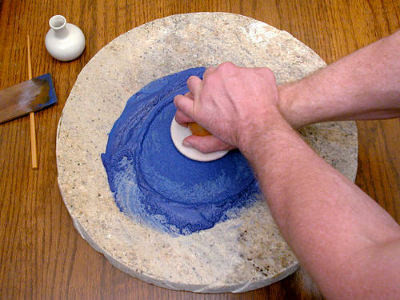 The
first step is to mull the lapis lazuli grit as fine as possible on the
slab. Even then, there will be a lot that is not fine enough, so I use
a medieval water levigation method to extract the fine from the coarse,
and then I mull the coarse grit until it is finally all perfect.
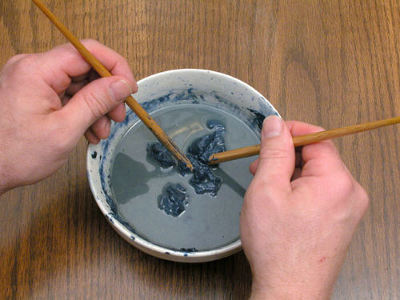 The
powder is melted with the wax and resins, kneeded like a putty, and
then put in a bowl of lye and worked with skicks. The blue comes out in
the lye and leaves the impurities in the putty. When the fluid is
poured off, it goes into a hollowed-out non-vitrious brick that pulls
the lye out and leaves only the ultramarine on the surface. The powder
is collected and can be mixed with binder to form paint.
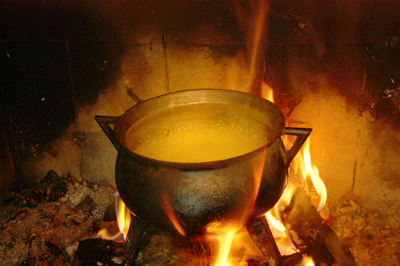 In this
reproduction 15th c. pot I am brewing weld plant tops (aka dyer's weed)
to make a yellow paint called Weld Lake, or in Italy, Arzica. This
beautiful yellow is a dye being extracted with hot potash lye. Then the
dye is stained onto chalk with alum. I collected this weld from the sea
shore in Sweden and I also grow it here in the USA. I washed the sticky
brown soot from the bottom of the pot with more lye and made the
pigment Bistre from it. Bistre is a warm, dark chocolate brown.
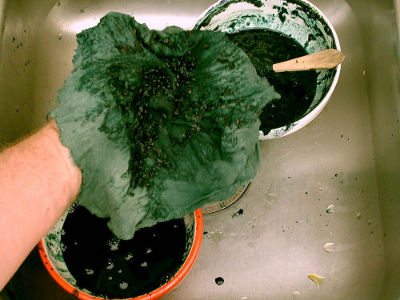 This is
sap green being made from buckthorne berries collected from my yard.
The darl purplish blue berry juice becomes a rich green when mixed with
alum in the presence of calcium such as sea shell.
Illuminating The Book 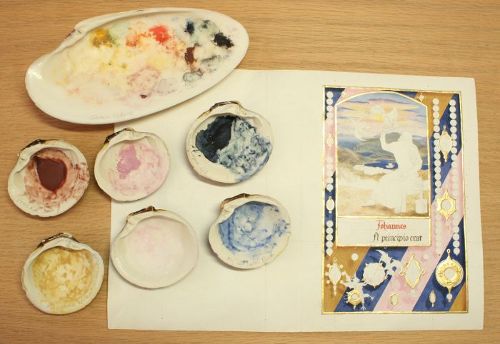 I use
shells as my palettes, just as was done in the middle ages. The colors
are mixed to general hues and values in single shells, and in the
renaissance a large shell or slab of ivory was used for the fine mixing
necessary for naturalistic painting. here are yellow ochre,
cochineal and lapis lazili being used to make the background panels in
the border. They are shaded with red ochre, less tinted cochineal, and
woad. This is the John on the Isle of Patmos full page miniature
from the Schiff book. I even went so far as to find a picture of the
view outside the cave where John wrote the Book of Revelations.
 I am
using genuine vermilion over yellow made from buckthorne berries to
make a wreath around an illumination of a skull in a mirror. The image
of death reflected in the mirror (memento mori) was a common medieval
image to remind us that we are all mortal. The flowery script is
decorated with cadel pen work.
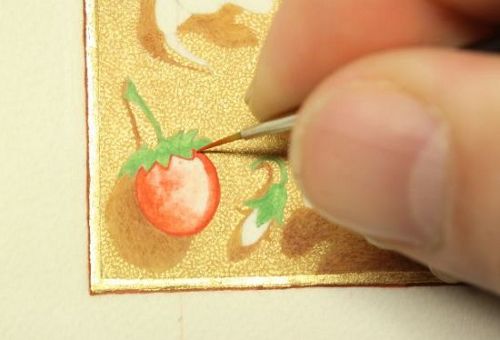 The
strawberry on the full page tromp l'oeil illumination of David in his
Penance is laid in with vermilion in this washes, and the green is a
combination of malachite mixed with a brilliant buckthorn yellow. The
yellow ochre background has been stippled with genuine gold paint to
make a shimmering effect.
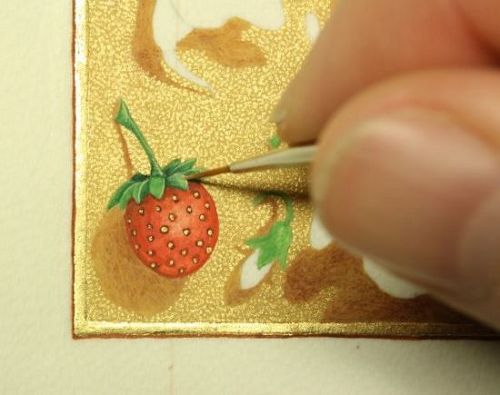 The image comes to life
as shadow tones are applied, and red ochre seed holes are dotted with
genuine gold paint.
NEXT The Final Illuminations and the Binding |